Characteristics of Ambient Black Carbon Mass and Size-Resolved Particle Number Concentrations during Corn Straw Open-Field Burning Episode Observations at a Rural Site in Southern Taiwan
Abstract
:1. Introduction
2. Methods
2.1. Monitoring Site, Monitoring Equipment, and Data Collection
2.2. Absorption Ångström Exponent Estimation
3. Results and Discussion
3.1. Meteorological Conditions during the Reference and Event Days
3.2. BC Concentration and Absorption Ångström Exponent Value during the Reference and Event Days
3.3. Total Particle and Ultrafine Particle Number Concentrations during the Reference and Event Days
3.4. Characteristic of Particle Number Size Distribution during Corn Straw Open-Field Burning
3.5. Short-Term Effect on the Air Quality during the Episode Period
3.6. Relationship between BC and Size-Resolved Particle Number Concentrations during the Non-Episode and Episode Periods
4. Conclusions
Acknowledgments
Author Contributions
Conflicts of Interest
References
- Torigoe, K.; Hasegawa, S.; Numata, O.; Yazaki, S.; Matsunaga, M.; Boku, N.; Hiura, M.; Ino, H. Influence of emission from rice straw burning on bronchial asthma in children. Pediatr. Int. 2000, 42, 143–150. [Google Scholar] [CrossRef] [PubMed]
- Andreae, M.O.; Merlet, P. Emission of trace gases and aerosols from biomass burning. Glob. Biogeochem. Cycle 2001, 15, 955–966. [Google Scholar] [CrossRef]
- Wu, C.F.; Jimenez, J.; Claiborn, C.; Gould, T.; Simpson, C.D.; Larson, T.; Liu, L.J.S. Agricultural burning smoke in eastern Washington: Part II. Exposure assessment. Atmos. Environ. 2006, 40, 5379–5392. [Google Scholar] [CrossRef]
- Estrellan, C.R.; Iino, F. Toxic emissions from open burning. Chemosphere 2010, 80, 193–207. [Google Scholar] [CrossRef] [PubMed]
- Zhang, H.; Hu, D.; Chen, J.; Ye, X.; Wang, S.X.; Hao, J.M.; Wang, L.; Zhang, R.; An, Z. Particle size distribution and polycyclic aromatic hydrocarbons emissions from agricultural crop residue burning. Environ. Sci. Technol. 2011, 45, 5477–5482. [Google Scholar] [CrossRef] [PubMed]
- Laumbach, R.J.; Kipen, H.M. Respiratory health effects of air pollution: Update on biomass smoke and traffic pollution. J. Allergy Clin. Immunol. 2012, 129, 3–11. [Google Scholar] [CrossRef] [PubMed]
- Bond, T.C.; Doherty, S.J.; Fahey, D.W.; Forster, P.M.; Berntsen, T.; DeAngelo, B.J.; Flanner, M.G.; Ghan, S.; Karcher, B.; Koch, D.; et al. Bounding the role of black carbon in the climate system: A scientific assessment. J. Geophys. Res. Atmos. 2013, 118, 5380–5552. [Google Scholar] [CrossRef]
- Ryu, S.Y.; Kwon, B.G.; Kim, Y.J.; Kim, H.H.; Chun, K.J. Characteristics of biomass burning aerosol and its impact on regional air quality in the summer of 2003 at Gwangju, Korea. Atmos. Res. 2007, 84, 362–373. [Google Scholar] [CrossRef]
- Franchini, M.; Mannucci, P.M. Shor-term effects of air pollution on cardiovascular diseases: Outcomes and mechanisms. J. Thromb. Haemost. 2007, 5, 2169–2174. [Google Scholar] [CrossRef] [PubMed]
- Pope, C.A.; Hansen, J.C.; Kuprov, R.; Sanders, M.D.; Anderson, M.N.; Eatough, D.J. Vascular function and short-term exposure to fine particulate air pollution. J. Air Waste Manage. Assoc. 2011, 61, 858–863. [Google Scholar] [CrossRef]
- Rice, M.B.; Ljungman, P.L.; Wilker, E.H.; Gold, D.R.; Schwartz, J.D.; Koutrakis, P.; Washko, G.R.; O’Connor, G.T.; Mittleman, M.A. Short-term exposure to air pollution and lung function in the Framingham Heart Study. Am. J. Respir. Crit. Care Med. 2013, 188, 1351–1357. [Google Scholar] [CrossRef] [PubMed]
- Cheng, M.T.; Horng, C.L.; Su, Y.R.; Lin, L.K.; Lin, Y.C.; Chou, C.C.K. Particulate matter characteristics during agricultural waste burning in Taichung City, Taiwan. J. Hazard. Mater. 2009, 165, 187–192. [Google Scholar] [CrossRef] [PubMed]
- Hays, M.D.; Fine, P.M.; Geron, C.D.; Kleeman, M.J.; Gullett, B.K. Open burning of agricultural biomass: Physical and chemical properties of particle-phase emissions. Atmos. Environ. 2005, 39, 6747–6764. [Google Scholar] [CrossRef]
- Oanh, N.T.K.; Ly, B.T.; Tipayarom, D.; Manandhar, B.R.; Prapat, P.; Simpson, C.D.; Liu, L.J.S. Characterization of particulate matter emission from open burning of rice straw. Atmos. Environ. 2011, 45, 493–502. [Google Scholar] [CrossRef] [PubMed]
- Yu, T.Y.; Lin, C.Y.; Chang, L.F.W. Estimating air pollutant emission factors from open burning of rice straw by the residual mass method. Atmos. Environ. 2012, 54, 428–438. [Google Scholar] [CrossRef]
- Zhang, Y.; Shao, M.; Lin, Y.; Luan, S.; Mao, N.; Chen, W.; Wang, M. Emission inventory of carbonaceous pollutants from biomass burning in the Pearl River Delta Region, China. Atmos. Environ. 2013, 76, 189–199. [Google Scholar] [CrossRef]
- Brown, J.S.; Zeman, K.L.; Bennett, W.D. Ultrafine particle deposition and clearance in the healthy and obstructed lung. Am. J. Respir. Crit. Care Med. 2002, 166, 1240–1247. [Google Scholar] [CrossRef] [PubMed]
- Delfino, R.J.; Sioutas, C.; Malik, S. Potential role of ultrafine particles in associations between airborne particle mass and cardiovascular health. Environ. Health Perspect. 2005, 113, 934–946. [Google Scholar] [CrossRef] [PubMed]
- Oberdörster, G.; Oberdörster, E.; Oberdörster, J. Nanotoxicology: An emerging discipline evolving from studies of ultrafine particles. Environ. Health Perspect. 2005, 113, 823–839. [Google Scholar] [CrossRef] [PubMed]
- Rich, D.Q.; Schwartz, J.; Mittleman, M.A.; Link, M.; Luttmann-Gibson, H.; Catalano, P.J.; Speizer, F.E.; Dockery, D.W. Association of short-term ambient air pollution concentrations and ventricular arrhythmias. Am. J. Epidemiol. 2005, 161, 1123–1132. [Google Scholar] [CrossRef] [PubMed]
- Jacobson, M.Z. Short-term effects of controlling fossil-fuel soot, biofuel soot and gases, and methane on climate, Arctic ice, and air pollution health. J. Geophys. Res. 2010, 115, D14209. [Google Scholar] [CrossRef]
- Power, M.C.; Weisskopf, M.G.; Alexeeff, S.E.; Coull, B.A.; Spin III, A.; Schwartz, J. Traffic-related air pollution and cognitive function in a cohort of older men. Environ. Health Perspect. 2011, 119, 682. [Google Scholar] [CrossRef] [PubMed]
- Fruin, S.; Westerdahl, D.; Sax, T.; Sioutas, C.; Fine, P.M. Measurements and predictors of on-road ultrafine particle concentrations and associated pollutants in Los Angeles. Atmos. Environ. 2008, 42, 207–219. [Google Scholar] [CrossRef]
- Boogaard, H.; Kos, G.P.; Weijers, E.P.; Janssen, N.A.; Fischer, P.H.; van der Zee, S.C.; de Hartog, J.J.; Hoek, G. Contrast in air pollution components between major streets and background locations: Particulate matter mass, black carbon, elemental composition, nitrogen oxide and ultrafine particle number. Atmos. Environ. 2011, 45, 650–658. [Google Scholar] [CrossRef]
- Reche, C.; Querol, X.; Alastuey, A.; Viana, M.; Pey, J.; Moreno, T.; Rodriguez, S.; Gonxalez, Y.; Fernández-Camacho, R.; de la Rosa, J.; et al. New considerations for PM, black carbon and particle number concentration for air quality monitoring across different European cities. Atmos. Chem. Phys. 2011, 11, 6207–6227. [Google Scholar] [CrossRef] [Green Version]
- Cheng, Y.H.; Lin, C.C.; Liu, J.J.; Hsieh, C.J. Temporal characteristics of black carbon concentrations and its potential emission sources in a southern Taiwan industrial urban area. Environ. Sci. Pollut. Res. 2014, 21, 3744–3755. [Google Scholar] [CrossRef] [PubMed]
- Shi, J.P.; Evans, D.E.; Khan, A.A.; Harrison, R.M. Sources and concentration of nanoparticles (<10 nm diameter) in the urban atmosphere. Atmos. Environ. 2001, 35, 1193–1202. [Google Scholar]
- Hussein, T.; Hämeri, K.; Aalto, P.P.; Paatero, P.; Kulmala, M. Modal structure and spatial-temporal variations of urban and suburban aerosols in Helsinki—Finland. Atmos. Environ. 2005, 39, 1655–1668. [Google Scholar] [CrossRef]
- Matson, U. Indoor and outdoor concentrations of ultrafine particles in some Scandinavian rural and urban areas. Sci. Total Environ. 2005, 343, 169–176. [Google Scholar] [CrossRef] [PubMed]
- Rodríguez, S.; Van Dingenen, R.; Putaud, J.P.; Dell’Acqua, A.; Pey, J.; Querol, X.; Alastue, A.; Chenery, S.; Ho, K.F.; Harrison, R.; et al. A study on the relationship between mass concentrations, chemistry and number size distribution of urban fine aerosols in Milan, Barcelona and London. Atmos. Chem. Phys. 2007, 7, 2217–2232. [Google Scholar] [CrossRef]
- Beckerman, B.; Jerrett, M.; Brook, J.R.; Verma, D.K.; Arain, M.A.; Finkelstein, M.M. Correlation of nitrogen dioxide with other traffic pollutants near a major expressway. Atmos. Environ. 2008, 42, 275–290. [Google Scholar] [CrossRef]
- Morawska, L.; Ristovski, Z.; Jayaratne, E.R.; Keogh, D.U.; Ling, X. Ambient nano and ultrafine particles from motor vehicle emissions: Characteristics, ambient processing and implications on human exposure. Atmos. Environ. 2008, 42, 8113–8138. [Google Scholar] [CrossRef] [Green Version]
- Hagler, G.S.W.; Baldauf, R.W.; Thoma, E.D.; Long, T.R.; Snow, R.F.; Kinsey, J.S.; Invernizzi, G.; Ruprecht, A.; Mazza, R.; De Marco, C.; et al. Measurement of black carbon concentration as an indicator of air quality benefits of traffic restriction policies within the ecopass zone in Milan, Italy. Atmos. Environ. 2011, 45, 3522–3527. [Google Scholar]
- Cheng, Y.H.; Shiu, B.T.; Lin, M.H.; Yan, J.W. Levels of black carbon and their relationship with particle number levels—Observation at an urban roadside in Taipei City. Environ. Sci. Pollut. Res. 2013, 20, 1537–1545. [Google Scholar] [CrossRef] [PubMed]
- Viidanoja, J.; Sillanpää, M.; Laakia, J.; Kerminen, V.M.; Hillamo, R.; Aarnio, P.; Koskentalo, T. Organic and black carbon in PM2.5 and PM10: 1 year of data from an urban site in Helsinki, Finland. Atmos. Environ. 2002, 36, 3183–3193. [Google Scholar] [CrossRef]
- Venkatachari, P.; Zhou, L.; Hopke, P.K.; Felton, D.; Rattigan, O.V.; Schwab, J.J.; Demerjian, K.L. Spatial and temporal variability of black carbon in New York City. J. Geophys. Res. 2006, 111, D10S05. [Google Scholar] [CrossRef]
- Wang, Y.; Hopke, P.K.; Rattigan, O.V.; Zhu, Y. Characterization of ambient black carbon and wood burning particles in two urban areas. J. Environ. Monit. 2011, 13, 1919–1926. [Google Scholar] [CrossRef] [PubMed]
- Westerdahl, D.; Fruin, S.; Sax, T.; Fine, P.M.; Sioutas, C. Mobile platform measurements of ultrafine particles and associated pollutant concentrations on freeways and residential streets in Los Angeles. Atmos. Environ. 2005, 39, 3597–3610. [Google Scholar] [CrossRef]
- Rodríguez, S.; Cuevas, E.; González, Y.; Ramos, R.; Romero, P.M.; Pérez, N.; Querol, X.; Alastuey, A. Influence of sea breeze circulation and road traffic emissions on the relationship between particle number, black carbon, PM1, PM2.5 and PM2.5–10 concentrations in a coastal city. Atmos. Environ. 2008, 42, 6523–6534. [Google Scholar] [CrossRef]
- Council of Agriculture. Agricultural Statistics Yearbook 2015; Council of Agriculture: Taipei, Taiwan, 2015. [Google Scholar]
- Lin, C.C.; Yang, L.S.; Cheng, Y.H. Ambient PM2.5, black carbon, and particle size-resolved number concentrations and the Ångström exponent value of aerosols during the firework display at the lantern festival in southern Taiwan. Aerosol Air Qual. Res. 2016, 16, 373–387. [Google Scholar] [CrossRef]
- Jeong, C.H.; Hopke, P.K.; Kim, E.; Lee, D.W. The comparison between thermal-optical transmittance elemental carbon and Aethalometer black carbon measured at multiple monitoring sites. Atmos. Environ. 2004, 38, 5193–5204. [Google Scholar] [CrossRef]
- Wu, C.F.; Larson, T.V.; Wu, S.Y.; Williamson, J.; Westberg, H.H.; Liu, L.J.S. Source apportionment of PM2.5 and selected hazardous air pollutants in Seattle. Sci. Total Environ. 2007, 386, 42–52. [Google Scholar] [CrossRef] [PubMed]
- Sandradewi, J.; Prévôt, A.S.H.; Weingartner, E.; Schmidhauser, R.; Gysel, M.; Baltensperger, U. A study of wood burning and traffic aerosols in an Alpine valley using a multi-wavelength Aethalometer. Atmos. Environ. 2008, 42, 101–112. [Google Scholar] [CrossRef]
- Kirchstetter, T.W.; Novakov, T.; Hobbs, P.V. Evidence that the spectral dependence of light absorption by aerosols is affected by organic carbon. J. Geophys. Res. 2004, 109, D21208. [Google Scholar] [CrossRef]
- Lewis, K.; Arnott, W.P.; Moosmüller, H.; Wold, C.E. Strong spectral variation of biomass smoke light absorption and single scattering albedo observed with a novel dual-wavelength photoacoustic instrument. J. Geophys. Res. 2008, 113, D16203. [Google Scholar] [CrossRef]
- Favez, O.; Alfaro, S.C.; Sciare, J.; Cachier, H.; Abdelwahab, M.M. Ambient measurements of light-absorption by agricultural waste burning organic aerosols. J. Aerosol. Sci. 2009, 40, 613–620. [Google Scholar] [CrossRef]
- Weingartner, E.; Saathoff, H.; Schnaiter, M.; Streit, N.; Bitnar, B.; Baltensperger, U. Absorption of light by soot particles: Determination of the absorption coefficient by means of aethalometers. J. Aerosol Sci. 2003, 34, 1445–1463. [Google Scholar] [CrossRef]
- Husain, L.; Dutkiewicz, V.A.; Khan, A.J.; Ghauri, B.M. Characterization of carbonaceous aerosols in urban air. Atmos. Environ. 2007, 41, 6872–6883. [Google Scholar] [CrossRef]
- Korenaga, T.; Liu, X.; Huang, Z. The influence of moisture content on polycyclic aromatic hydrocarbons emission during rice straw burning. Chemosphere-Glob. Chang. Sci. 2001, 3, 117–122. [Google Scholar] [CrossRef]
- Yang, H.H.; Tsai, C.H.; Chao, M.R.; Su, Y.L.; Chien, S.M. Source identification and size distribution of atmospheric polycyclic aromatic hydrocarbons during rice straw burning period. Atmos. Environ. 2006, 40, 1266–1274. [Google Scholar] [CrossRef]
- Keshtkar, H.; Ashbaugh, L.L. Size distribution of polycyclic aromatic hydrocarbon particulate emission factors from agricultural burning. Atmos. Environ. 2007, 41, 2729–2739. [Google Scholar] [CrossRef]
- Lu, H.; Zhu, L.; Zhu, N. Polycyclic aromatic hydrocarbon emission from straw burning and the influence of combustion parameters. Atmos. Environ. 2009, 43, 978–983. [Google Scholar] [CrossRef]
- Reid, J.S.; Koppmann, R.; Eck, T.F.; Eleuterio, D.P. A review of biomass burning emissions part II: Intensive physical properties of biomass burning particles. Atmos. Chem. Phys. 2005, 5, 799–825. [Google Scholar] [CrossRef]
- Janhäll, S.; Andreae, M.O.; Pöschl, U. Biomass burning aerosol emissions from vegetation fires: Particle number and mass emission factors and size distributions. Atmos. Chem. Phys. 2010, 10, 1427–1439. [Google Scholar] [CrossRef]


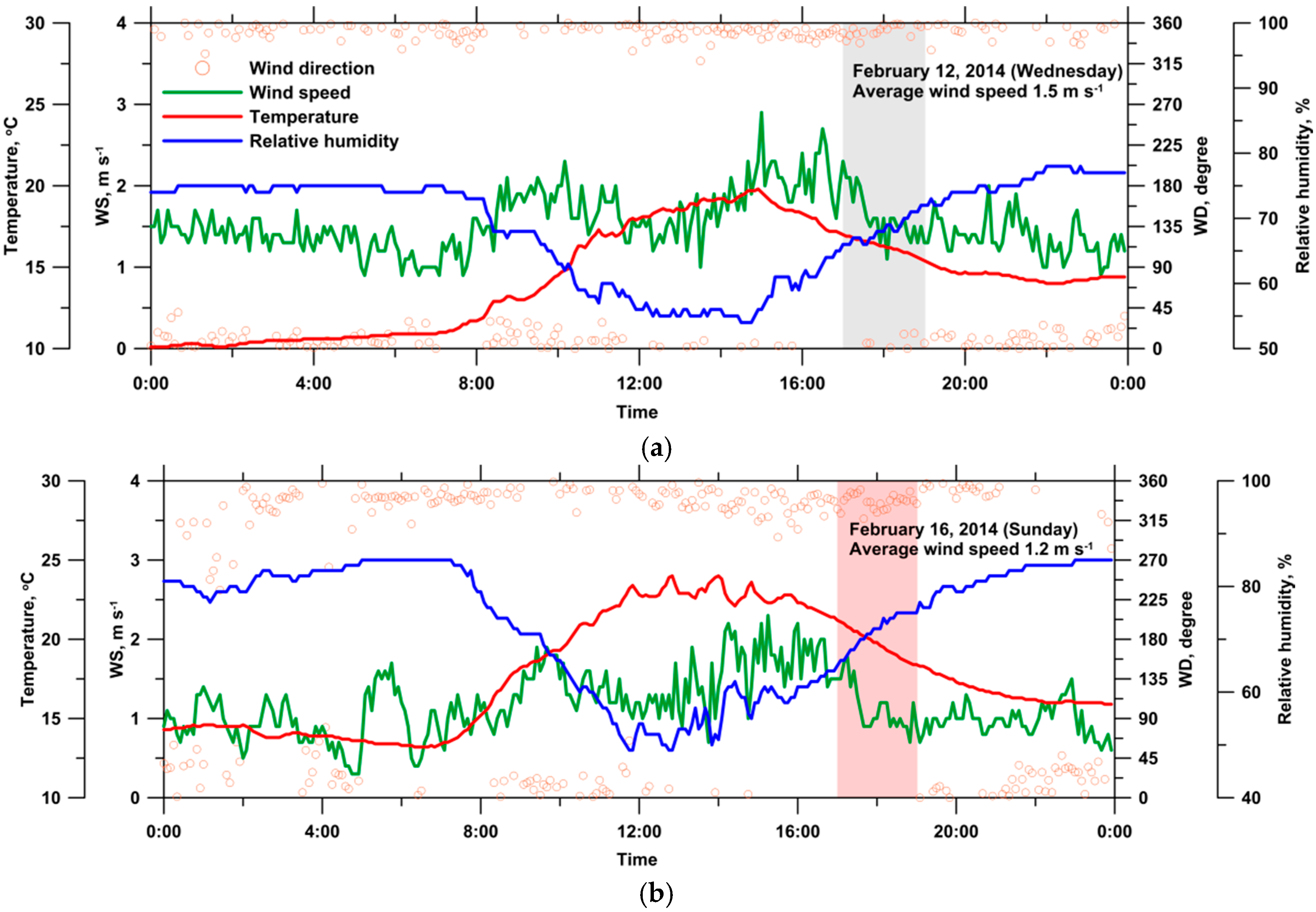
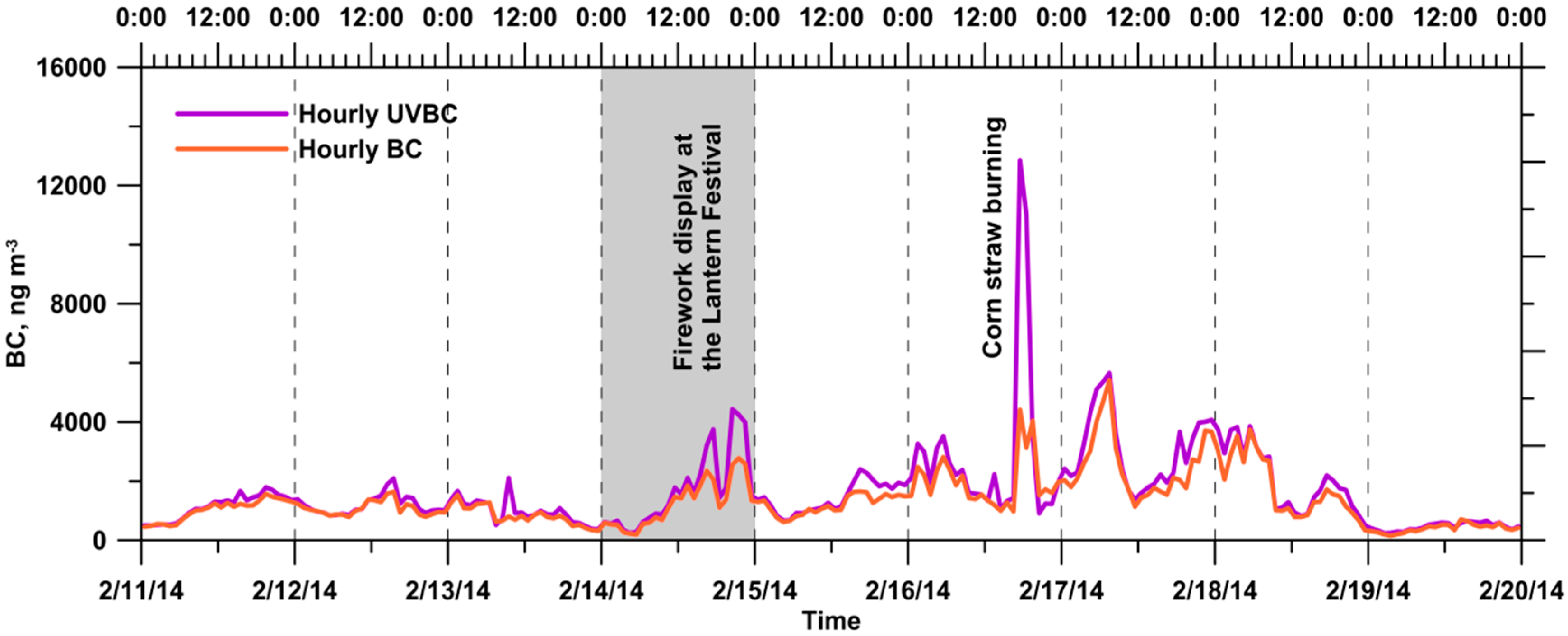
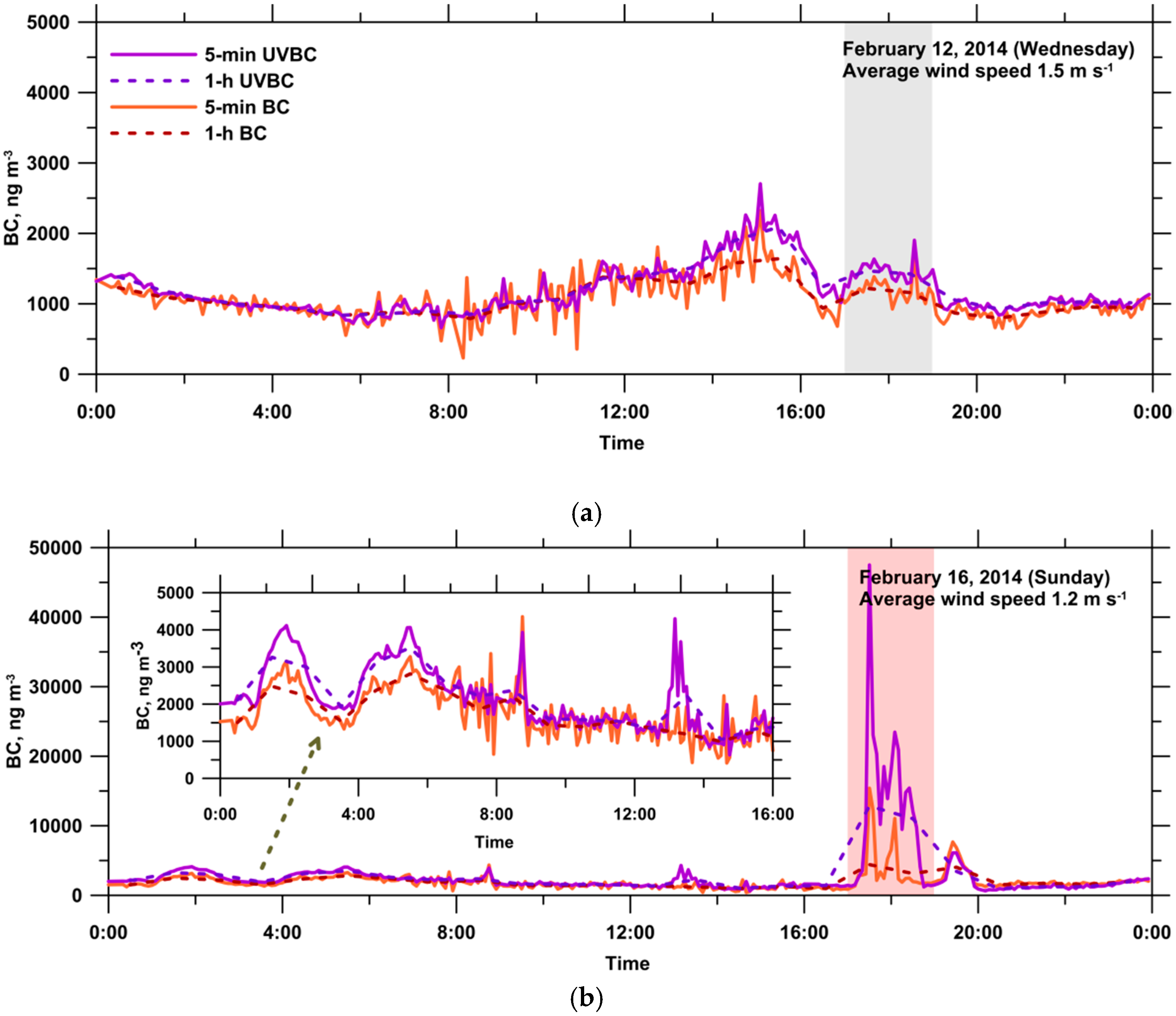
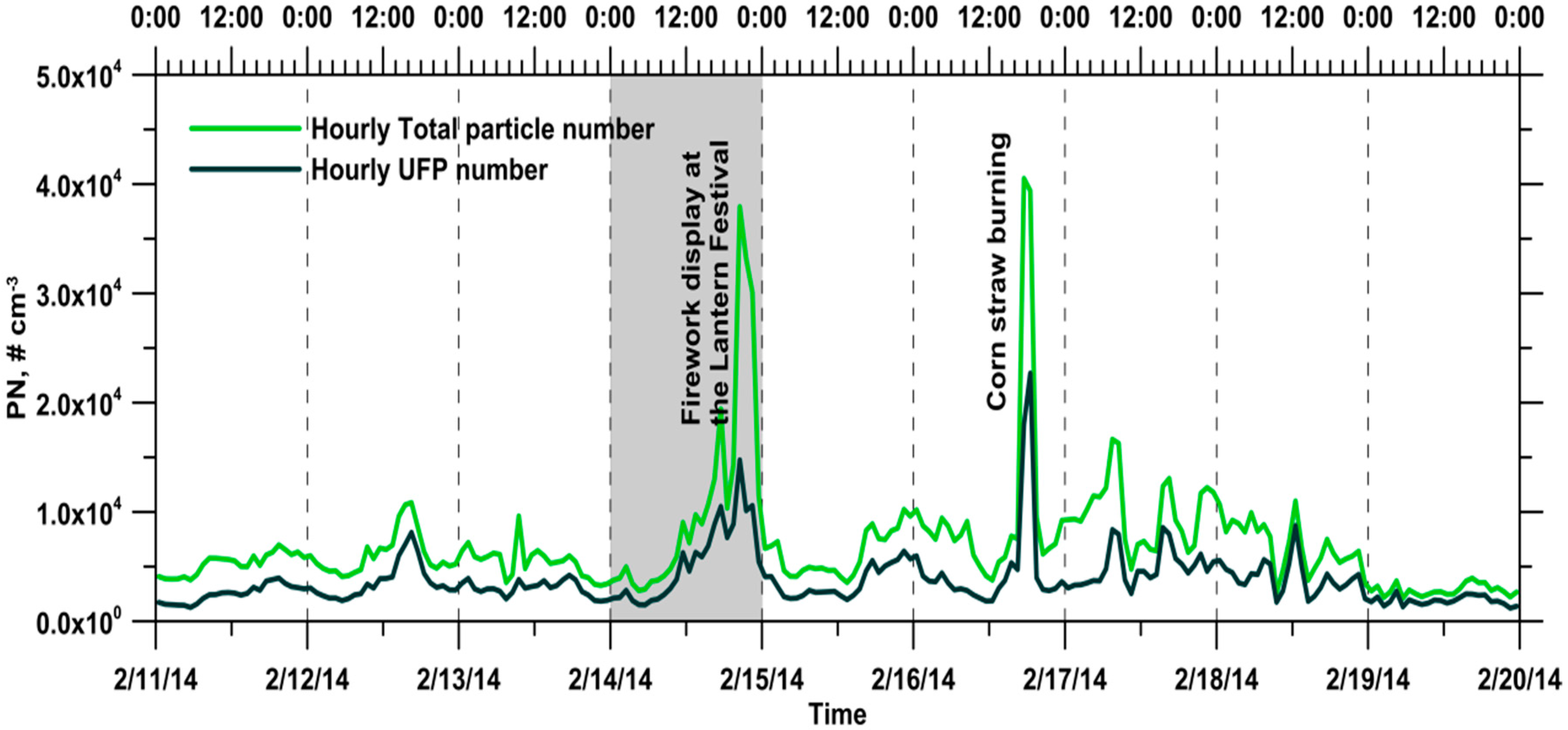
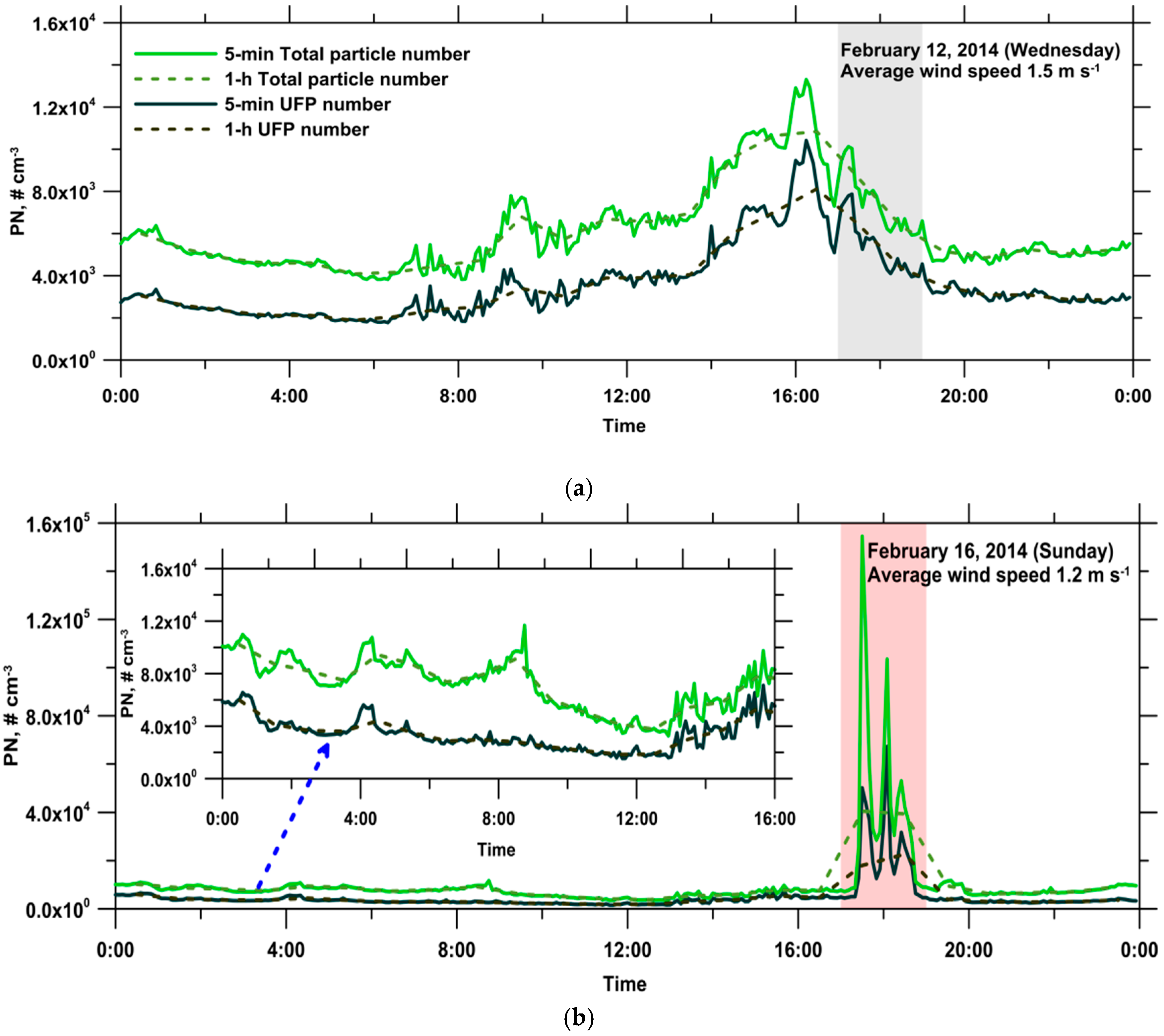
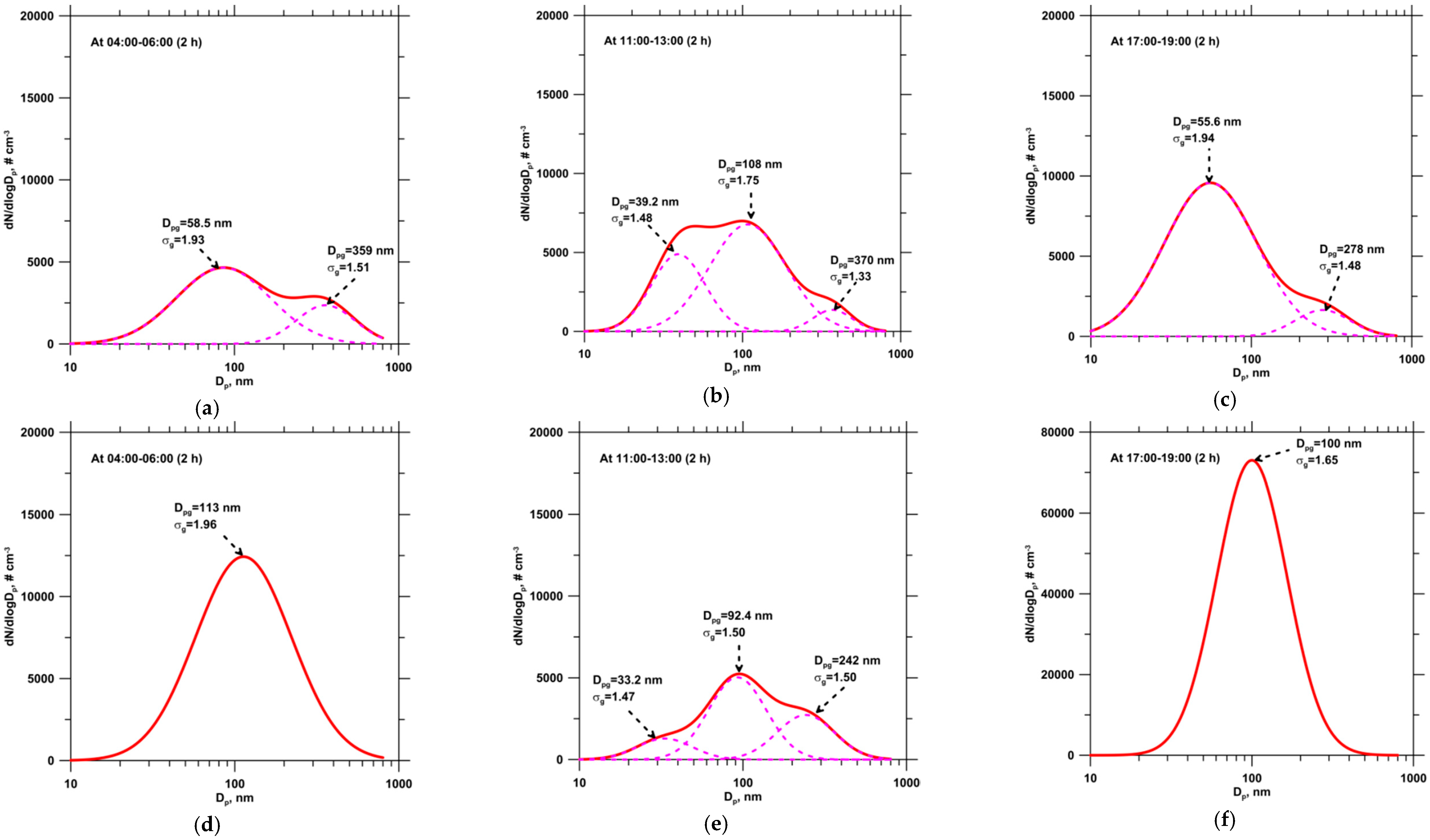
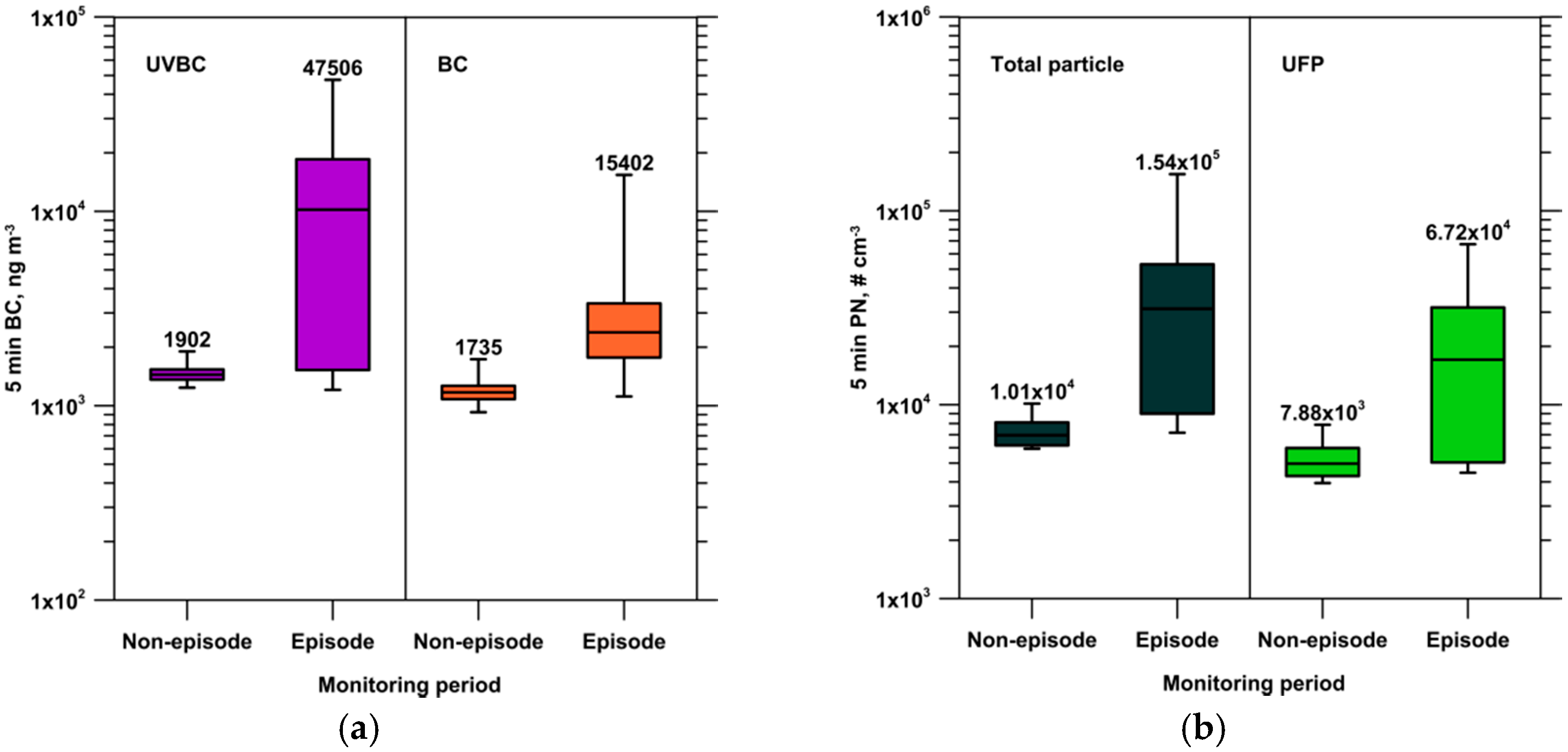
| Monitoring Period | Wind Speed m·s−1 | Wind Direction | Temperature °C | Relative Humidity % |
|---|---|---|---|---|
| Non-episode period a | 1.6 | NNW-NNE | 16.2 | 68.4 |
| Episode period b | 1.1 | NW-N | 19.7 | 71.8 |
| Monitoring Period | 18–32 nm | 32–56 nm | 56–100 nm | 100–180 nm | 180–320 nm | 320–560 nm | Other Size c |
|---|---|---|---|---|---|---|---|
| Particle number, cm−3 | |||||||
| Non-episode period a | 1.12 × 103 | 2.15 × 103 | 2.12 × 103 | 1.05 × 103 | 5.83 × 102 | 2.68 × 102 | 1.85 × 102 |
| (15.0%) | (28.7%) | (28.3%) | (14.1%) | (7.8%) | (3.6%) | (2.5%) | |
| Episode period b | 3.58 × 102 | 4.47 × 103 | 1.50 × 104 | 1.52 × 104 | 3.74 × 103 | 5.07 × 102 | 1.36 × 102 |
| (2.1%) | (11.2%) | (37.6%) | (38.1%) | (9.4%) | (1.3%) | (0.3%) |
| Monitoring Period | 18–32 nm | 32–56 nm | 56–100 nm | 100–180 nm | 180–320 nm | 320–560 nm | Other Size c |
|---|---|---|---|---|---|---|---|
| Non-episode period a | 0.209 | 0.090 | 0.041 | 0.195 | 0.566 | 0.597 | 0.239 |
| Episode period b | 0.107 | 0.518 | 0.827 | 0.910 | 0.845 | 0.794 | 0.643 |
© 2016 by the authors; licensee MDPI, Basel, Switzerland. This article is an open access article distributed under the terms and conditions of the Creative Commons Attribution (CC-BY) license (http://creativecommons.org/licenses/by/4.0/).
Share and Cite
Cheng, Y.-H.; Yang, L.-S. Characteristics of Ambient Black Carbon Mass and Size-Resolved Particle Number Concentrations during Corn Straw Open-Field Burning Episode Observations at a Rural Site in Southern Taiwan. Int. J. Environ. Res. Public Health 2016, 13, 688. https://doi.org/10.3390/ijerph13070688
Cheng Y-H, Yang L-S. Characteristics of Ambient Black Carbon Mass and Size-Resolved Particle Number Concentrations during Corn Straw Open-Field Burning Episode Observations at a Rural Site in Southern Taiwan. International Journal of Environmental Research and Public Health. 2016; 13(7):688. https://doi.org/10.3390/ijerph13070688
Chicago/Turabian StyleCheng, Yu-Hsiang, and Li-Sing Yang. 2016. "Characteristics of Ambient Black Carbon Mass and Size-Resolved Particle Number Concentrations during Corn Straw Open-Field Burning Episode Observations at a Rural Site in Southern Taiwan" International Journal of Environmental Research and Public Health 13, no. 7: 688. https://doi.org/10.3390/ijerph13070688






